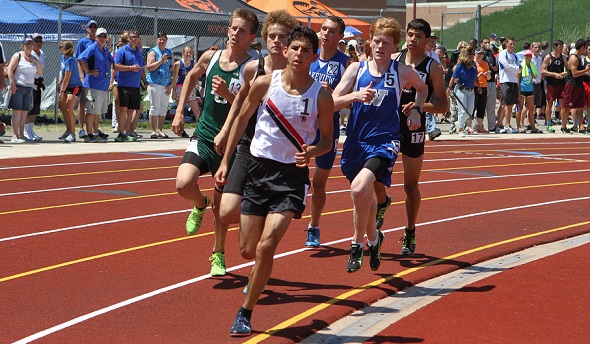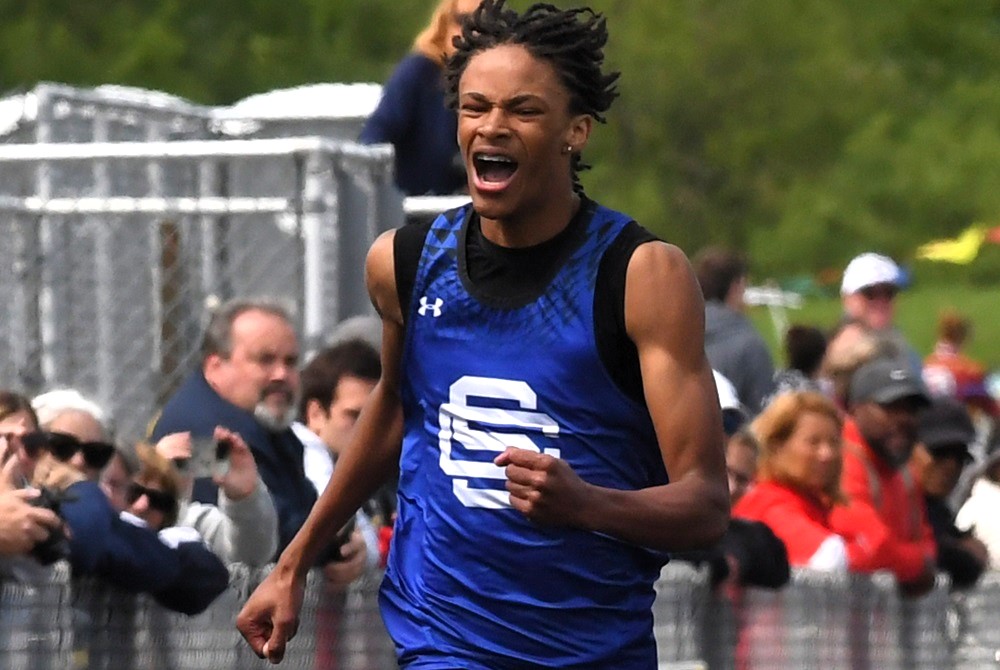
Fisher Goes the Distance at LP D1 Final
May 31, 2014
By Bill Khan
Special to Second Half
ROCKFORD — Grant Fisher wasn't going to get snuck up on again.
As a sophomore last year, Fisher came down the final stretch with the lead in the 1,600-meter run at the MHSAA Lower Peninsula Division 1 Track and Field Final, only to be caught from behind by Lake Orion's T.J. Carey and lose by sixth-thousandths of a second.
The Grand Blanc distance star made up for it later in the day by winning the 3,200, then went on to win the MHSAA Division 1 and Foot Locker national cross country championships in the fall.
The one title he still lacked was the MHSAA 1,600 crown, which he took care of Saturday by jumping out to the lead and never looking back.
Fisher won in 4:10.82, having built a sizable cushion over fast-finishing Traverse City Central sophomore Anthony Berry, who took second in 4:12.64.
"Last year in the last 100 meters I got caught by T.J.," Fisher said. "That was a really disappointing one, because I was so close. This year, I wanted to get a victory this time and I didn't want to leave it too close to call. Usually, I sit and kick, but today it's about winning. I'll do what it takes to win."
With a 1,600 victory under his belt, Fisher took a different approach a couple hours later in the 3,200. He sat behind Royal Oak's Ben Hill until 200 meters remained, then won a sprint to the finish with a time of 9:07.11, covering the final lap in 59 seconds. Hill took second in 9:09.34.
Fisher became only the second boy in the last 12 years to sweep the distance events in LP Division 1, the last being Monroe's Justin Heck in 2008. Of seven runners who have swept the 1,600 and 3,200 in LP Class A or Division 1, only future Olympian Dathan Ritzenhein of Rockford had a faster combined time. Ritzenhein posted times of 4:08.08 and 9:00.63 in 2000.
"My plan going into the race was with 150 (meters) to go to make a move," Fisher said. "That's what I did. I had to wait like that, because I was pretty tired from the mile. That was a huge goal of mine to win the mile and two mile."
Fisher wasn't the only boy to turn in elite-level performances.
Junior Donavan Brazier of Grand Rapids Kenowa Hills set an MHSAA all-Finals record in the 800 with a time of 1:50.24. He broke the mark of 1:50.63 set by Rick Gledhill of Mt. Clemens Chippewa Valley in the 1988 LP Class A meet. Brazier was pushed down the stretch by Waterford Mott's Brennan Munley (second in 1:51.79) and Milford's Brian Kettle (third in 1:52.39).
"A 1:50 was pretty surprising," Brazier said. "I was hoping for a (personal record) from 1:52. I just hung on until the last 200 and gave it all I've got."
Saline's 3,200 relay team of John Davis, Ryan Gauche, Ryan Wilkie and Logan Wetzel set an all-Finals record with a time of 7:40.54, breaking Saline's mark of 7:41.27 set in 2004. Victory wasn’t even a given until Wetzel overtook Okemos on the final lap after the Hornets were in third place for much of the race. Wetzel ran a 1:50 closing leg.
"It's really hard to press in that last 200, 300 meters when you're all alone," Wetzel said. "Definitely having a guy to battle with made all the difference."
Oak Park senior Maurice Allen had the stamina to complete a difficult double, winning the 400 in 48.13 seconds and coming back three events later to take the 200 in 21.36. Earlier, he ran on a second-place 800 relay team.
"You're tired, but the thing is to get out in the lead in the first part of the race," Allen said. "If you can start, you can finish."
The only other athlete to win two individual events was Swartz Creek senior thrower Kevin Weiler. Weiler won the discus at 176 feet, 5 inches and the shot put at 60 feet, 4.5 inches.
East Kentwood won its fifth team championship in six years, scoring 71 points to beat Oak Park by 21. Saline was third with 37 points.
"It's one of those things where we're not necessarily winning everything, but we're taking seconds and thirds and scoring twice in events," East Kentwood coach Dave Emeott said. "It's a very special group of kids who worked crazy hard."
Antoine Lloyd, Kevin Smith and Devin McKinney each scored in four events for the Falcons. Lloyd had a hand in 27 points, winning the 110 high hurdles, taking second in the 300 hurdles, taking fourth in the high jump and running on a fifth-place 1,600 relay team. McKinney scored 25 points, taking third in the 110 hurdles; running on the winning 800 relay team with Smith, Ashley Bailey and Michael Catching; running on a sixth-place 400 relay team; and taking third in the 200. Smith had a hand in 23 points. He was on the winning 800 relay team.
PHOTO: Grand Blanc’s Grant Fisher leads a pack around a turn during the 1,600 at the Lower Peninsula Division 1 Final on Saturday at Rockford High School. (Click to see more from RunMichigan.com.)

Performance of the Week: Southfield Christian's Brock Morris
June 5, 2025
 Brock Morris ♦ Southfield Christian
Brock Morris ♦ Southfield Christian
Senior ♦ Track & Field
Morris finished an individually-phenomenal day at Saturday's Lower Peninsula Division 4 Finals by helping his teammates make school history. With Southfield Christian trailing leader Kalamazoo Hackett Catholic Prep by three points heading into the final event of the day, Morris anchored the Eagles' 1,600 relay and crossed the finish line first – which, combined with Hackett's third-place finish in the race, gave Morris and his teammates their school's first Finals team championship in track & field by one point.
That victory capped a day that also saw Morris win the 200 and 400-meter open races and run on the winning 800 relay as well. Morris was part of school records in all four of those races this season and the 400 relay as well; the 1,600 relay time of 3:24.36 on Saturday lowered that school record and also included Dylan Taylor-Wilkerson, Robert Brown and Jadon Staten. Morris also ran cross country and played point guard on the boys basketball team. He will study at University of Michigan, majoring in biology, health and society on a pre-medical track.
@mhsaasports 🏃♂️POW: Brock Morris #southfieldchristian #track #finals #winner #1600relay #anchor #part1 #highschoolsports #tiktalk #interview #performanceoftheweek #mistudentaid #fyp #MHSAA ♬ original sound - MHSAA
@mhsaasports 🏃♂️POW: Brock Morris #instagram #chocolatemilk #hidden #talent #emoji #part2 #performanceoftheweek #mistudentaid #fyp #MHSAA ♬ Monkeys Spinning Monkeys - Kevin MacLeod & Kevin The Monkey
Follow the MHSAA on TikTok.
MHSAA.com's "Performance of the Week" features are powered by MI Student Aid, a division within the Department of Lifelong Education, Advancement, and Potential (MiLEAP). MI Student Aid encourages students to pursue postsecondary education by providing access to student financial resources and information. MI Student Aid administers the state’s 529 college savings programs (MET/MESP), as well as scholarship and grant programs that help make college Accessible, Affordable and Attainable for you. Connect with MI Student Aid at www.michigan.gov/mistudentaid and find more information on Facebook and Twitter @mistudentaid.
Previous 2024-25 honorees
May 30: Chloe Qin, Bloomfield Hills Cranbrook Kingswood tennis - Report
May 23: Drew Goik, Bay City Western golf - Report
May 15: Sydney Kuhn, Saginaw Swan Valley track & field - Report
May 8: Ryan Bosch, Fruitport baseball - Report
May 1: Jackson Lam, Kalamazoo Loy Norrix track & field - Report
April 25: Isabelle Horvath, Bangor softball - Report
April 18: Presley Jones, Sterling Heights Stevenson soccer - Report
April 11: Olivia Jasniewicz, Troy soccer - Report
March 27: Katie Spicer, Fowler basketball - Report
March 21: Moses & Markus Blackwell; Warren Lincoln basketball - Report
March 13: Keyshawn Summerville, Lansing Sexton basketball - Report
March 6: Maggie Buurma, Fowlerville wrestling - Report
Feb. 28: Maren Studt, Pontiac Notre Dame Prep skiing - Report
Feb. 21: Olive Krueger, Marquette swimming - Report
Feb. 14: Hunter Lemmon, Fraser swimming - Report
Feb. 7: Aubrey Hillard, Rochester competitive cheer - Report
Jan. 31: Wyatt Spalo, Reed City wrestling - Report
Jan. 24: Olivia Flynn, Harbor Springs basketball - Report
Jan. 17: Levi Rozema, Holland Christian swimming - Report
Jan. 10: McRecco McFadden, Burton Bentley basketball - Report
Dec. 18: Nash Leonard, Bay City Western hockey - Report
Dec. 11: Blake Cosby, Dundee wrestling - Report
Dec. 4: Keaton Hendricks, Zeeland West football - Report
Nov. 29: Kate Simon, East Grand Rapids swimming - Report
Nov. 22: Ella Kokaly, Essexville Garber volleyball - Report
Nov. 15: Caroline Bryan, Grosse Pointe South swimming - Report
Nov. 8: Kaylie Livingston, Whitmore Lake cross country - Report
Oct. 25: Oliver Caldwell, Grand Rapids West Catholic tennis - Report
Oct. 18: Alex Graham, Detroit Cass Tech football - Report
Oct. 11: Victoria Garces, Midland Dow cross country - Report
Oct. 4: Asher Clark, Bay City John Glenn soccer - Report
Sept. 26: Campbell Flynn, Farmington Hills Mercy volleyball - Report
Sept. 19: TJ Hansen, Freeland cross country - Report
Sept. 12: Jordan Peters, Grayling soccer - Report
Sept. 6: Gabe Litzner, Sault Ste. Marie cross country - Report
Aug. 30: Grace Slocum, Traverse City St. Francis golf - Report
(Photo by RunMichigan.com.)

